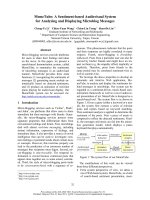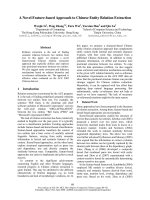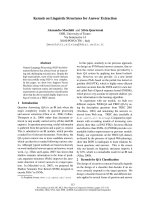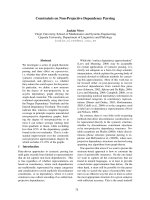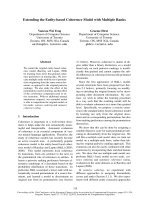Báo cáo khoa học: "INFERENCING ON LINGUISTICALLY BASED STRUCTURE" doc
Bạn đang xem bản rút gọn của tài liệu. Xem và tải ngay bản đầy đủ của tài liệu tại đây (516.22 KB, 7 trang )
INFERENCING ON LINGUISTICALLY BASED ZZ~IANTIC STRUCTUR~F
Eva Ilaji~ov~, Milena Hn~tkov~
Department of Applied Mathematics
Faculty of Mathematics and Physics
Charles University
~lalostransk4 n. 25
118 O0 Praha I, Czechoslovakia
ABSTRACT
The paper characterizes natural lang-
uage inferencing in the TIBAQ method of
question-answering, focussing on three asp-
ects: ~i) specification of the structures
on which the inference rules operate, (ii)
classification of the rules that have been
formulated and implemented up to now,
according to the kind of modification of
the input structure ti~e rules invoke, an~
(iii) discussion of some points in which
a proverly designed inference procedure
may help the searc~ of the answer, and
vice versa.
I SPECIFICATION OF THE I:~PUT STRUCTURES
FOR INFE~ENC I[IG
A. Outline of the TIBAQ ~lethod
hhen the TIBA~ (~ext-and-~nference
based ~nswering of ~uestions) project was
~esigned, main emphasis was laid on the
automatic build-up of the stock of know-
ledge from the (non-~re-edited% input text.
The experimental system based 6n this meth-
od converses automatically the natural
language input (both the questions and new
Fieces of information, i.e. Czech sentences
in their usual form) into the reDresentat-
ions of n,eaning (tectogranmlatical repres-
entations, TR's]; these TR's serve as input
structures for the inference procedure tilat
enriches the set of TR's selected by the
system itself as possibly relevant for an
answer to the input question. In this en-
riched set suitable TR's for direct and in-
direct answers to the given question are
retrieved, and then transfered by a synth-
esis procedure into the output (surface)
form if sentences (for an outline of the
method as such, see Haji~ov~, 197~; 3aji~o-
v~ and Sgall, 19~i; Sgall, 1982).
B. :?hat Kind of Structure Inferences ~houl~i
Be Based on
To decide what kind of structures the
inference procedure should operate, one has
to take into account several criteria, some
of which seemingly contradict each other:
the structures should be as simple and
transparent as possible, so that inferenc-
ing can be perfor,ued in a well-defined way,
and at the s~e ti~ue, these structures
~hould be as"exDressive"as the natural lang-
uage sentences are, not to lose any piece
of information captured by the text.
"~atural language has a major draw-
back in its ambiguity: when a listener is
told that the criticisl~ of the Polish del-
egate was fully justified, one does not
know (unless indicated by the context or
situation) whether s/he should infer that
soE~eone criticized the Polish delegate, or
whether the Polish delegate criticized
someone/something. On the other hand, there
are means in natural language that are not
preserved by most languages that logicians
have used for drawing consequences, but
that are critical for the latter to be
drawn correctly: when a listener is told
that ~ussiau is ~poken in SIBERIA, s/he
draws conclusions partly different from
those when s/he is told that in Siberla,
RUS3IAN is spoken (caoitals denoting the
intonation center); or, to borrow one of
the widely discussed examples in linguist-
ic writings, if one hears that Jonn called
:ary a ~U~LICA~ and that then she insult-
ed I~IM, one should infer that the sneaker
considers "being a ~eoublican" an insult~
this is not the case, if the speaker said
that then she I~SULTED hi~.
These and similar considerations have
led the authors of TIDAn to a stronc con-
viction that the structures representing
F.nowledge and serving as the base for in-
ferencing in a q-uestion-answerin[~ system
with a natural language interface should
be linguistically based: they should be de-
prived of all ambiguities of natural lang-
uage and at the same til:ie they should pre-
serve all the information relevant for
drawing conclusions that the natural lanci-
uage sentences encompass. The exr.erir,~ental
syster~, based on TI~A(:, which was carried
out by the group of formal linauistics at
Charles University, Prague [implemented on
~C 1040 c~:n?11ter, compatible with 15::4 360)
works with representations of :~eaning (te-
ctogrammatical representations, fR's2
worked nut in the framework of functional
generahive descrintion, or ~GD (for the
linguistic background of this aopro~ch we
refer to Sgall, 1964; ~;~all et ai.,1959;
291
Haji~ov~ and Jgall, 19:~O
).
C. l ectocrar.~n~tical
~eor:_'sentations
One of the b~sic tenets of VGD is
the articulation of the sc'~antic relation,
i.e. th_- relation bet.:een sound and r,~ean-
ing, into a hierarchy o[ levels, connected
with the relativiz~tion o[ the rel~tion of
form" an~ 'function' a:~ known from the
• ~;ritings of
Prague
&chool sc'nolar,3. This
relativizatio~ .iakes it i~ossibl , to di'~t-
ingui.~h t::o levels of se:,tence structure:
the level of surface syntax and that of
t~e underlying or tectogramomatical struct-
ure of sentences.
As for a forn~al specification of the
comolex unit oF- this lev,;l, that is the T!~.,
the [)re~{ent version (see :'l.<ite]-, Sgall
an/ qgall, in }~ress) w~rks ::ith the notion
of basic .]e})endency structure (5DR) ,;hich
is defined a~ ] structure over the aloha-
bet A (corres\~onding to tne labels of no~l-
es) and the set of sy~,~ools C (corres~ond-
ing.to the labels of e'lqes). 'i'he set of
5Dr- s is the sec of the tectogra:unatical
representations of sentences containing
no coordinated structures. 'fi%e ~-]Dq s are
generated by the gra:,~.~ar G = (V.,V ,5,q),
where V = A ka C, A = {(a ~, ,~)], a is in-
T
terpreted as a lexical unit, g is a vari-
aole standing for t and f (contextually
bound and non-bound, res~ectively] an., ~
is internreted as a set of <Ira,~,~aten~es be-
longing to a; C is a '~et of com~)lementat-
ions (c ~ C, where c is an inter;or denot-
ing a certain type of comi~ler.'entation,
called a functor),C" lenotes the set
[<, >, %, >c~ for uvery C ~ C.
%'o reuresent coordination, the form-
al a~paratus for sentence generation is to
be complemented by another aluhabet Q,
,here q ~ e is interpreted as tynes of
coordination (conjun~ive, disjunctive, ad-
versative, , ap}9osition) , .Ind by ~ ne',,!
kinu of brackets denotinq the boundary of
coordinated structures; .3"={[ , ~, ] for
every q ~ ~. The structures generated oy
the grammar are then called comT~lex '.]e:gend-
ency str~ctures (CD~).
Coming back to the notions of elem-
entary and com~!ex units of the tecto-
gra~c, atical level, we can say that the
comnlex unit of the TR is the com?lex de-
pendency structure as briefly characteriz-
ed above, while the ele.nentary units are
the symbol~ of ti~e shaoes a, g, c, q, the
ele[:ents of 3"~, and the ~arentheses. 'i'he
lexical units a are conceiv ,<~ of as elem-
entary rather th~n zom:_~lex, since for the
time being we .1o not work with anv kind of
lexical d~co.,;>osition. ,'.very le:~ical unit
is assig~le]
V.n~:
[eat:/re conte.':tually
bound" or 'non-bound" . The set of gra.'nmat-
e~,~zs GR cov:_'rs a :;ide ranme o£ [}henomena;
they can be classifie,i into two groups.
Grammatemes representing morphological
rleanin C in the narrow sense are specific
for different (semantic) word classes: for
nouns, w~ distinguish grammatemes of num-
ber an~ of delimitation (indefinite, def-
inite, specifying):for adjectives and ad-
verbs, grammate~es of degree, for verbs,
we work with grammatemes of aspect (pro-
cessual, complex, resultative), iterative-
hess (iterative, non-iterative), tense
(simultaneous, anterior, posterior), im-
:nediateness (immediate, non immediate),
predicate modality (indicative, Dossibil-
itive, necessitive, voluntative), assert-
ive modality (affirmative, negative), and
sentential modality (ieclarative, inter-
rogative, imperative). The other group o~
gr~mmatemes is not - with some exceptions -
%~ord-class specific and similarly as the
set of the types of complementations is
closely connected with the kinds of the
dependency relations between the governor
and the dependent node; thus the Locative
is accom}~anied by one member of the set
{in, on, under, between ].
%'he dependency relations are very
rich and varied, and it is no wonder that
there were many efforts to classify them.
In
FGD, a
,lear boundary is being made be-
tween -~tJcipants (deep cases) and(free)
modifications: participants are those com-
!~lementations that can occur with the same
verb token only once and that have to be
sr~uci~ied for each verb (and similarly for
each noun, adjective, etc.), while free
modifications are those comolementations
that may appear more than once with the
same verb token and that can be listed for
all the verbs once for all; for a ~ore
detaile:i discussion and the use of operat-
ional criteria for this classification,
see ?anevov~ 1974; 1980; Eaji~ov~ and
Panevov~, in press; Haji~ov~, 1977; 1983.
Doth ;~articipants and modifications can
be (semantically) optional or obligatory;
~oth optional and obligatory oarticiDants
are to be stated in the case frames of
verbs, while modificatiors belong there
only with such verbs with which they are
obligatory.
In the nresent version of FGD, the
following five participants are disting-
uished: actor/bearer, patient (objective),
addressee, origin, an~ effect. The list
o4 ~odifications is by far richer and more
differentiated; a good starting ~oint for
tills differentiation can be found in Czech
gram~lars (esp. ~milauer, 1947). %'bus one
can arrive at the following grou~?ings:
(a) local: where, lirection, "~lhich
~:ray,
(b) tem~3oral: when, since when, till when,
how long, for ho%J long, luring,
(c) causal: cause, condition real and un-
rdal, aim, concession, consequence,
(d) manner: manner, regard, extent, norm
(criterion) , substitution, accompani-
ment, means (instrument), difference,
292
benefit, comparison.
In our discussion on types of complementat-
ions we have up to now concentrated on comp-
lementations of verbs; with Zhe FGD frame-
work, however, all word classes have their
frames. Specific to nouns (cf. Pi[ha, 1980),
there is the partitive participant (a glass
of water) and the free modifications of
appurtenance (a leg of the table], of gen-
eral relationship (nice weather), of ident-
ity (the city of Prague] and of a descript-
ive attribute (golden Prague).
To illustrate the structure of the re-
presentation on the tectogrammatical level
of FG;), we present in Fi~. $ a com21ex de-
pendency structure of one of the readings of
of the sentence "Before the ~ar began,
Charles lived in P~AGUE and Jane in BFRLIN"
(which it has in cormnon with "Before the be-
ginning of the war, Charles lived in PRAGUE
and Jane lived in rSERLIN ~) ;to make the
graph easier to survey, we omit there the
values of the gram.~atemes.
lize t AND live t
~arlest ~ Prague f ~ane t % Berlin f
the linearized form:
<~war t, {sing, def])>Act (beglnt' {enter, compl, noniter, nonimmed, indic,lffirm,
before]]>whe n (<(Charles t, {sing, det]].~Ac t (live t, {enter, compl, noniter, non-
inmled, decler, indie,effirm]] whe~re(Pregue f, {sing,def,in])> < ( Janet; {sing,
def] ] .~ct (liver' {enter, eompl, noniter,nonirmled, declar, indic, affirm)) where
(Berlin , {sing, def, in)] >SAND
Fic.f. 1
II INFERENCE TYPES
A. [q_eans of Implementation
The inference rules are progranm~ed
in 9-1anguage (Colmerauer, 1982), which
provides rules that carry out transforr~at~
ions of oriented graphs. Since the struct-
ures accepted by the rules must not con-
tain complex labels, every complex sy~bol
labelling a no~e in WR's has the form of a
whole subtree in the Q-language notation
(in a "~-tree).
The set of TR's constitutes a seman-
tic network, in which the individu~l T!{'s
are connected into a com[~lex whole hy
means of pointers between tl]e occurrences
of lexical units and the corresponding
entries in the lexicon. (Ouestions of dif-
ferent objects of the same kind referred
to in different TR's will be handled only
in the future ex]~eriments.)
The following procedures eperate o~n
TI{ "s :
(i] the extraction of (possibly] relevant
pieces of information from the stock
of kno,:?led~e ;
(ii] the application of inference rules on
the relevant }?ieces of information,
(iii) the retrieval of the answer(s).
']:he extraction of the so-calleE rs-
levant .~J~c,~s of inforT~'.~tion is based on
~:atcbing the. ~"~ of the input question with
the lexicon and extracti~,~ khos¢: Y[''<~ that
intersect with the Tq o~ the give,: questi-
on in at least one s~ ecific 1 ~c~_ v~lue
(i.e. other than the"g~nerll %ztor, -~.,:.
one, the copula, etc.] ; the rezt cf the
t r~es (s~]~-~oscd to }:~. irreluvant for ~h
,liven questJ.~n) are th?.n d~let_~,}
The set of i".!:~,'~nt U'. "'-~ [~{ c,-cr-ztmi
U.:O~l k. V t['~: rules o~ i~r-~r
~.",.cc.
r f [, rui.?
of in.fer~=r, Ce l ;z bee-] ? ~-li? ~, '::th i:h,.::
293
source TR as well as the derived TR consti-
tute a part of the stock of knowledge a,,d
a,, serve as source TR s for further pro-
cessing. In order to avoid infinite cycles,
the whole proced :r= oI inferencing is div-
ided into several Q-systems (notice that
rules within a single Q-system are applied
s ~o,:g as the conditions for their applic-
ation are fulfilled, i.e. there is no order-
ing of the rules ).
E. Types of Inference Rules
I. Rules operatin@ on a single TR:
(i) the structure of the tree is preserv-
ed; the transformation concerns only (a)
part(s) of the .o p~ex symbol of some node
of the CDS (i.e. label(s) of some node(s)in
the Q-tree of the TR):
(a) change of a grammateme:
V exform-POssib (Ndevice-ACt)
(X-Pat) ==
Vperform-lndic INdevice -Act)
~X-Pat)
A0te:, In our highly simplified and
schematic shapes of the rules we quote
only thos~ labels of the nodes that
are relevlnt for the rule in question;
the sign == stands for "rewrite as";
Ndevice stands for any no~n ,,i%h the
sem~,~t£u f=ature of "device", Vperfor m
for a verb with the semantic feature
of action ve£b=, ~ossib and II~dic de-
note the |raimnatemes of predicate mod-
ality.
E x.: An implifier can activate a Das,
ive network to form an active analogue.
== An amplifier activates a passive
network to form an active anal~gue.
(b) change of a functor (type of complement-
ation):
V-use (Ni-Pat) (Nj-Accomp) ==
V-use (Ni-Regard) (~j-Pat)
E__{x.: Operational amplifier is used with
negative feedback. == With operational
a,uplifier negative feedback is used.
Vperfor m LNi-Act ) (Nj-Pat) ==
Vperfor m (Dgen-ACt) (~li-Instr) (Nj-Pat)
E x.: Operational amplifiers perform
mathematical operations == Mathematic-
al operations are performed by means
of operational amplifiers.
Note: Act, Pat, Instr, Accomp, Reg-
ard stand for the functors of Actor,
Patient, Instrument, Accompaniment
and Regard, respectively; D denot-
es a general participant, gen
~g~ change of the lexical part of the comp-
lex symbol accompanied by a change of
some gramnlateme or functor:
V Possibl ((few)Ni) (V-use(Nk-ACc°mpneg)
) ==Vi-Necess ((most)Ni) (V-use
( Nk-ACcompposit) )
Ex.: With few hlgh-performance oper-
a-~ional amplifiers it is possible to
maintain a linear relationship betw-
een input and output without employ-
ing negative feedback.== Hith most
&i. it is necessary to maintain
employing negative feedback.
(ii) a whole subtree is replaced by another
subtree:
Ex.: a negative feedback == a negat-
ive feedback circuit
(iii) extraction of a subtree to create an
independent TR:
- relative clause in the topic part
of the TR
V i (Vj-Gener-L( )) ==
Vj-Gener-L ( )
Ex.: An operational amplifier, which
a ~tivates a passive network to form
an active analogue, is an unusually
versatile device. == An operational
amplifier activates a passive net-
work to form an active analogue.
Note: L stands for the grammateme
"contextually bound", R for "non-
-bound", Gener for the functor of
general relationship.
-
causal clause in TR's with affir-
mative modality
Vi-Affirm (Vj-Cause ( )) ==
vj
t )
EX.: Since an operational amplifier
i-~ designed to perform mathematical
operations, such basic operations
as are performed readily. ==
An operational amplifier is designed
to perform mathematical operations.
- deletion of an attribute in the
focus part of a TR
V i (Nj-R (X-Gener-R))
V i (Nj-R)
i 6 0
294
E_~x.: Operational amplifiers are used
as regulators to minimize load-
ing of reference ~]iod~ vermittlng
full exploitation of the diode's
precision temperature stability. ==
Operational amplifiers are used as
regulators to minimize loading
of reference diodes.
(iv) the transformation gives rise to two
TR s
distributivity of conjunction and
disjunction (under certain condit-
ions: e.g. for the distributivity
of disjunction to hold, the gramm-
ateme of Indic with the main verb
is replaced by the grammateme of
Possib)
E x.: Operational amplifiers are used
in active filter networks to provide
gain and frequency selectivity. ==
Operatinal amplifiers are used in
active filter networks to provide
gain. Operational amplifiBrs are
used in active networks to provide
frequency selectivity.
2. Rules operatin 9 (simultaneously) on two
TR s
left-hand side of the rule refers
to two TR's)
-
conjoining of TR's with the same
Actor
Ex.: An operational amplifier act-
ivates a passive network to form an
active analogue. An operational
amplifier performs mathematical op-
erations. =~ An operational amplif-
ier activates and performs
use of definitions: the rule is
triggered by the presence of an as-
sertion of the form "X is called Y"
and substitutes all occurrences of
the lex~cal labels X in all TR's by
the lexical label Y
III
EFFECTIVE LINKS BETWEEN INFERENCING
AND ANSWER RETRIEVAL
A. The Retrieval Procedure
Th~ retrieval of an answer in the en-
riched set of assertions (TR's) is perform-
ed in the following stepsl
(a) first it is checked whether the
lexical value of the root of the TR is id-
entical with that of the TR of the question;
if the question has the form "What is per-
formed (done, carried out) by X?", then
the TR from the enriched set must include
an action verb as a label of its root;
(b) the path leading from the root to the
wh-word is checked (yes-no questions are.
excluded from the first stage of our exper-
iments); the rightmost path in the relevant
TR must coincide with the wh-path in its
lexical labels, contextual boundness,
grammatemes and functors (with some poss-
ible deviations determined by conditions
of substitutability: Singular - Plural,
Manner - Accompaniment, etc.); the wh-word
in the question must be matched by ~-lex-
ical unit of the potential answer, where
the latter may be further expanded;
(c~ if also the rest of the two compared
TR s meet the conditions of identity or
substitutability, the relevant TR is mark-
ed as a full answer to the given question;
if this is not the case but at least one
of the nodes depending on a node included
in the wh-path meets these conditions, then
the relevant TR is marked as an indirect
(partial) answer.
B. Towards an Effective Application of
Inference Rules
In the course of the experiments it
soon became clear that even with a very
limited number of inference rules the mem-
ory space was rapidly exceeded. It was
then necessary to find a way how to achie-
ve an effective application of the inferen-
ce rules and at the same time not to re-
strict the choice of relevant answers.
Among other things, the following issues
should be taken into consideration:
The rules substituting subtrees for
subtrees are used rather frequently, as
well as those substituting only a label
of one node (in the Q-tree, i.e. one ele-
ment of the complex symbol in the CDS),
preserving the overall structure of the
tree untouched. These rules operate in
both directions, so that it appears as use-
ful to use in such cases a similar strat-
egy as with synonymous expressions, i.e.
to decide on a single representation both
in the TR of the question and that includ-
ed in the stock of knowledge; this would
lead to an important decrease of the num-
ber of TR's that undergo further inference
transformations.
Only those TR's are selected for the
final steps of the retrieval of the answer
(see point (a) in III.A) that coincide
with the TR of the question in the lexical
label of the root, i.e. the main verb. If
the inference rules are ordered in such a
way that the rules changing an element of
the label of the root are applied before
the rest of the rules, then the first
step of the retrieval procedure can be
made before the application of other in-
ference rules. This again leads to a con-
295
siderable reduction of the number of TR's
on which the rest of the inference rules
are applied; only such TR's are left in the
stock of relevant TR's
(i)that agree with the TR of the question
in the label of the root (its ~exical lab-
el may belong to superordinated or subord-
inated lexioal values: device - amplifier,
etc.),
(ii) that i~clude the lexical label of
the root oC the question in some other
place than at the root of the relevant
TR,
(iii) if the question has the form "Which
N " (i.e the wh-n~de depends on its
• o- , o
head in the relation of general relation-
ship), then also those TR's are preserved
that contain an identical N node (noun)
on any level of the tree.
The use of Q-language brings about
one difficulty, namely that the rules
have to be formulated for each level for
the tree separately. It is possible to
avoid this complication by a simple tempor-
ary rearrangement of the Q-tree, which re-
sults in a tree in which all nodes with
lexical labels are on the same level; the
rules for a substitution of the lexical
labels can be then applied in one step,
after which the tree is "returned" into
its original shape.
These and similar considerations have
led us to the following ordering of the in-
dividual steps of the inference and retrie-
val procedure:
I. application of rules transforming
the input structure to such an extent that
the lexlcal label of the root of the tree
is not preserved in the tree of a potent-
ial answer;
2. a partial retrieval of the answer
according to the root of the tree;
3. application of rules substituting
other labels pertinent to the root of the
tree;
4. partial retrieval of the answer
according to the root of the tree;
5. application of inference rules
operatinq on a single tree;
6. application of inference rules
operating on two trees;
7. the steps (b) and (c) from the
retrieval of the answer (see III.A above).
REFERENCES
Colmerauer A., 1982, Les systemes Q ou un
formalisme pour analyser et syn=n& T
tiser des phra~;es sur ordinateur,
mimeo; Germ.transl. in: Prague Bull.
of ~4athematical Linguistics 38,
1982, 45-74.
Haji~ov~ E., 1976, Question and Answer in
Linguistics and in Man-Machine Com-
munication, SMIL,No.I,36-46T
Haji~ov~ E., 1979, Agentive or Actor/Bear-
er, Theoretical Linguistics 6,
173-190.
Haji~ov~ E., 1983, Remarks on the Meaning
of Cases, in Prague Studies in
Mathematical Linguistics 8, 149-157.
Haji~ov~ E. and J. Panevov~, in press,
Valency (Case) Frames of Verbs, in
Sgall, in press.
Haji~ov~ E. and P. Sgall, 1980, Linguistic
Meaning and Knowledge Representat7
ion in Automatic Understanding of
Natural Language, in COLING 80 -
Proceedings, Tokio, 67-75; reprint-
ed in Prague Bulletin of Mathemat-
ical Linguistics 34, 5-21.
Haji~ov~ E. and P. Sgall, 1981, Towards
Automatic Understanding of Techn-
ical Texts, Prague Bulletin of
Mathematical Linguistics 36, 5-23.
Panevovl J., 19~4, On Verbal Frames in
Functional Generative Description,
Part I, Prague Bulletin of Mathem-
atical Linguistics 22, 3-40; Part
II, PBML 23, 1975, 17-52.
Panevov~ J., 1980, Formy a funkce ve stav-
b~ ~esk4 v~ty /Forms and Functions
in the Structure of Czech Sentence/,
Prague
Pi£ha P., 1980, Case Frames for Nouns, in
Linguistic Studies Offered to B.
Siertsema, ed. by D.J.v.Alkemade,
Amsterdam, 91-99
Pl~tek M., Sgall J. and P. Sgall, in press,
A Dependency Base for a Linguistic
Description, to appear in Sgall,
in press.
Sgall P., 1964, Zur Frage der Ebenen in
Sprachsystem, Travaux linguistiques
de Prague I, 95-106.
Sgall P.
, 1982, Natural Language Understand-
ing and the Perspectives of Questi-
on Answering, in COLING 82, ed.
by J. Horeckg, 357-364.
296
Sgall P., ed., in press, Contributions to
Functional Syntax, Semantics and Lang-
uage Comprehension, to appear in Am-
sterdam and Prague.
Sgall P., Nebesk9 L., Goral~fkov~ A. and
E. Haji~ovl, 1969, A Functional
Approach to Syntax, New York.
~milauer V., 1947, Novo~esk~ skladba
/A Present-Day Czech Syntax/, Prague.
297

